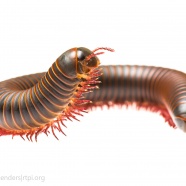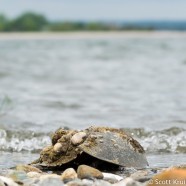Roly-poly-pede
This Giant Millipede (Narceus americanus) doesn’t really have 1,000 legs. However, like all millipedes, it has two pairs of extremities on each of its body segments (centipedes always have only a single pair per body segment). Unlike their centipede ‘cousins’, millipedes lack the modified jaw-like first pair of legs that predatory centipedes use to catch and sometimes envenomate their prey. Instead, millipedes defend themselves by rolling into a tight spiral and/or using chemical defenses that can include cyanide! Worst case scenario, handling one of these beautiful ‘roly-poly-pedes’...
Read MoreTagged Horseshoe Crab
I found this deceased Horseshoe Crab at Bridgeport, Connecticut’s Pleasure Beach in June. As you can see it has a large tag on it from the U.S. Fish & Wildlife Service. Here along the Connecticut coast Sacred Heart University is studying the Horseshoe Crab through Project Limulus. This effort monitors populations, helps to track individuals by tagging, seeks to better understand their biology, and works to aid the spawning process by protecting the species and educating the public. Learn more by visiting their website! I reported this individual, a male, which I was told was first...
Read MoreHorseshoe Crabs
If you are on the Atlantic Coast during the late spring you may be fortunate enough to find Horseshoe Crabs during the breeding season. Early June, especially around a new or full moon, is a very busy time for these marine arthropods that are considering living fossils, having existed nearly unchanged for approximately 450 million years. These photos were taken at Stratford Point in Stratford, Connecticut, an important mating site at the mouth of the Housatonic River. The females will lay eggs on beaches like this one, some subsequently being eaten by migrant shorebirds. The most vivid...
Read More






